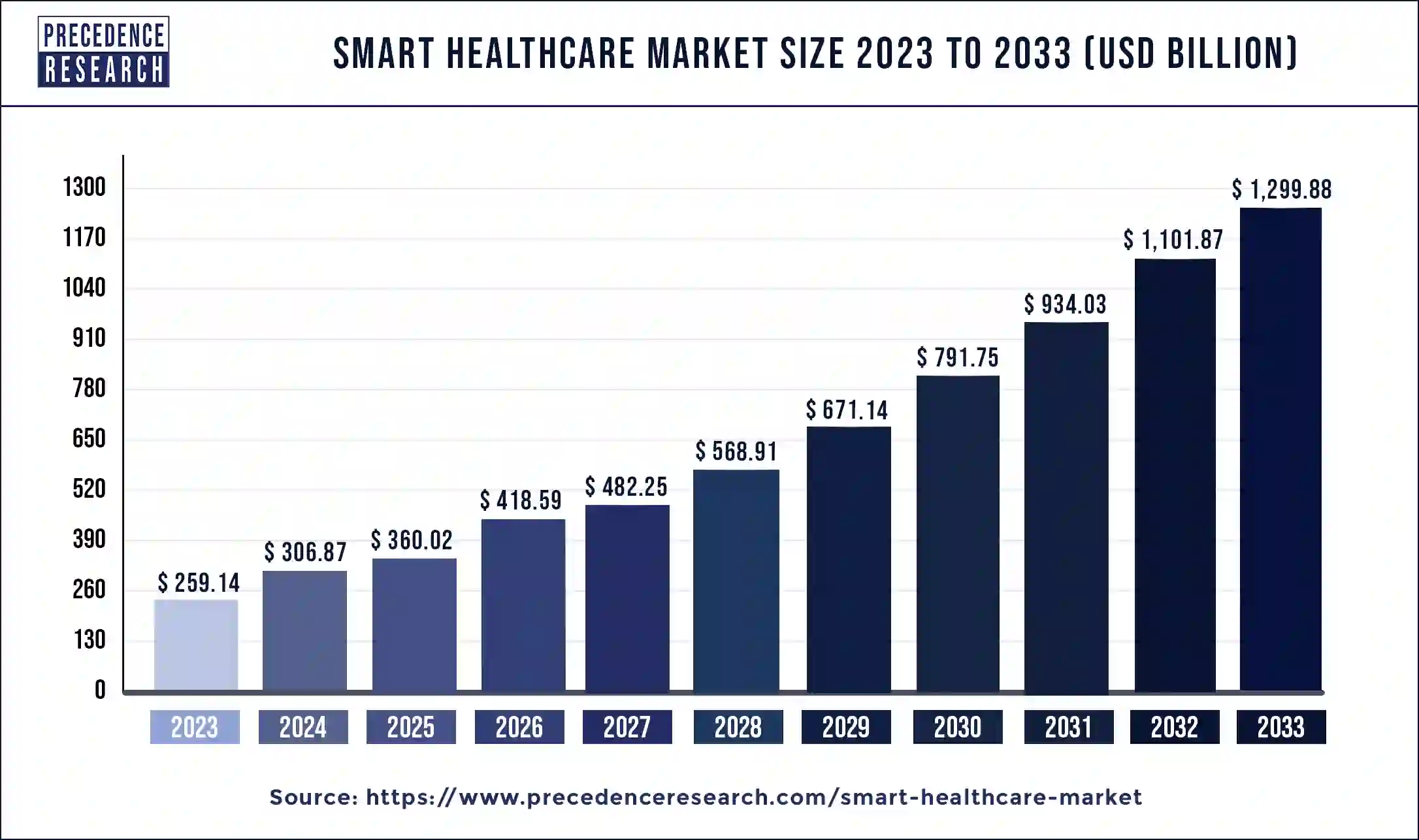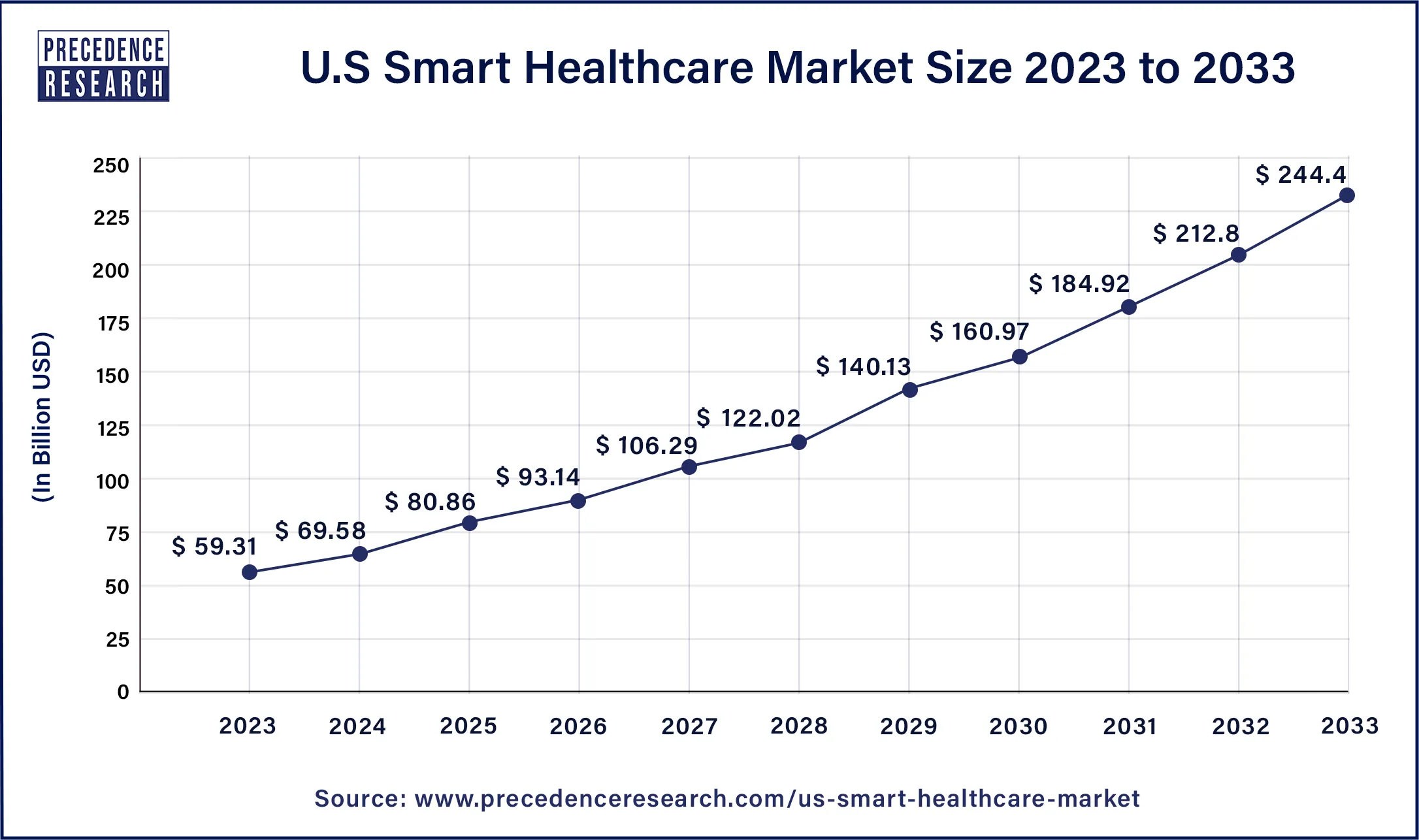The global smart healthcare market size accounted for USD 418.59 billion in 2026 and is estimated to cross over USD 1,497.89 billion by 2034, forecasted to advance at a double-digit CAGR of 17.18% between 2025 and 2034. Market growth is fueled by the rising prevalence of chronic diseases, increasing adoption of telemedicine and mHealth solutions, and rapid advancements in AI, IoT, and wearable devices.

The Full Study is Readily Available | Download the Sample Pages of this Report@ https://www.precedenceresearch.com/sample/1173
Smart Healthcare Market Overview
How is Smart Healthcare Market Growing?
Smart healthcare is a platform for the healthcare system that uses technologies like big data, machine learning, Internet of Things, artificial intelligence, and many more to enhance patient care. Smart healthcare focuses on creating personalised, interconnected, and intelligent healthcare infrastructure. It optimizes resource allocation, enhances patient care, and streamlines various operations.
It uses technologies to connect doctors, healthcare providers, patients, and hospitals. Smart healthcare collects data through sources like electronic health records, wearables, and sensors to understand healthcare system performance, patient health, and diseases. Smart healthcare includes remote patient monitoring, smart medication management, wearable devices, AI-powered diagnostics, and smart home healthcare.
Smart Healthcare Market Highlights:
- In terms of revenue, the smart healthcare market is expected to reach USD 360.02 billion in 2025.
- It is forecasted to hit an estimated USD 1,497.89 billion by 2034, driven by digital health innovations and rising chronic disease burden.
- North America held a market share of 17.18% in 2024.
- Asia Pacific region is estimated to expand the fastest CAGR of 24.68% between 2025 and 2034.
- By product, the telemedicine segment registered a maximum market share of 42.42% in 2024.
Case Study: Remote Patient Monitoring in Action – A Transformational Shift in Diabetes Care
One of the most impactful examples of smart healthcare adoption comes from the integration of remote patient monitoring (RPM) platforms for diabetes management. In India, where nearly 101 million people live with diabetes, healthcare providers have increasingly turned to RPM solutions to reduce hospital visits and improve daily care.
Patients using connected glucometers, wearable patches, and mobile health apps are able to track their blood sugar levels in real time. These data points are automatically transmitted to cloud-based platforms, where AI algorithms analyze fluctuations and alert both patients and physicians of any critical deviations.
A 2024 pilot program run jointly by a leading hospital group in Bengaluru and a digital health startup demonstrated significant outcomes:
- 30% reduction in hospital admissions linked to diabetic complications.
- Improved medication adherence, as patients received personalized reminders via smartphone apps.
- Enhanced doctor-patient communication, with physicians able to review health dashboards remotely and adjust treatment plans accordingly.
This case underscores the core growth drivers of the smart healthcare market — an aging population, rising prevalence of chronic conditions, and demand for cost-efficient, real-time care delivery. By leveraging connected devices, big data, and AI-driven insights, healthcare systems are moving closer to personalized, proactive, and preventive healthcare.
What are the Growth Factors for the Smart Healthcare Market?
- The growing prevalence of chronic diseases like cancer, cardiovascular conditions, and diabetes requires continuous monitoring.
- The increasing adoption of telehealth apps, wearable devices, and smartphone apps.
- The strong government support for the digitalization of the healthcare industry.
- The rising demand for personalized medicine and remote patient monitoring.
- The ongoing advancements in medical devices.
Top Smart Healthcare Applications in India:
| Apps | Features |
| Tata 1 mg |
|
| Practo |
|
| MFine |
|
| Netmeds |
|
| PharmEasy |
|
Smart Healthcare Market Opportunity
What is an Opportunity for the Smart Healthcare Market?
Growing Demand for Remote Patient Monitoring
The growing prevalence of chronic diseases like hypertension, diabetes, & heart disease, and an aging population, increases the demand for remote patient care (RPM). It offers early detection of any potential issues and prevents further complications. It offers customized treatment plans and optimizes patient care. The growing patient demand for making informed decisions and accurate information to monitor health requires RPM. The increasing demand for virtual monitoring and consultations in remote areas increases the adoption of the RPM.
The increasing focus on reducing healthcare costs by healthcare systems and patients increases demand for RPM. The growing advancements, like implantable devices and wearable devices, lead to higher demand for RPM. The growing focus on expanding healthcare in rural communities fuels the adoption of RPM. The growing demand for remote patient monitoring creates the opportunity for the smart healthcare market.
Limitations and Challenges in the Smart Healthcare Market
What is the Limitation of the Smart Healthcare Market?
High Initial Investment Limits the Adoption of Smart Healthcare
Despite several benefits of smart healthcare in patient care, the high initial investment restricts the market growth. Factors like infrastructure upgrade, customization, stringent security measures, and high technology cost are responsible for the high initial investment. The development of diagnostic tools, medical devices, and sensors is expensive. The IT infrastructure, like powerful computing resources, high-speed networks, and secure data storage, requires a high initial investment.
The development of software for telemedicine, AI-powered analytics, EHRs, and remote patient monitoring requires a high initial investment. The cost of upgrading existing or building new healthcare facilities is high. The growing customization of smart healthcare increases the cost. The high initial investment hampers the growth of the smart healthcare market.
Read Also: E-bike Market Size to Worth USD 165.69 Billion by 2034
Smart Healthcare Market Key Regional Analysis:
How Big is the U.S. Smart Healthcare Market?
The U.S. smart healthcare market size accounted for USD 69.58 billion in 2024 and is expected to rise from USD 80.86 billion in 2025 to approximately USD 276.00 billion by 2034, at a CAGR of 14.77% from 2025 to 2034.

How did North America Dominate the Smart Healthcare Market in 2024?
North America dominated the smart healthcare market in 2024. The well-established technological infrastructure, like a strong presence of technological companies, high-speed internet, and rising smartphone usage, increases focus on the development of smart healthcare. The presence of advanced healthcare systems like personalised medicine, electronic health records, and telehealth services helps the market growth.
The strong government support for smart healthcare solutions and digital health increases the development of smart healthcare infrastructure. The growing prevalence of chronic disease and rising healthcare spending increases demand for smart healthcare solutions. The rapid adoption of connected healthcare technologies like remote patient monitoring, wearable devices, and mHealth drives the overall growth of the market.
Asia Pacific Smart Healthcare Market Trends:
Asia Pacific is experiencing the fastest growth in the market during the forecast period. The growing prevalence of chronic conditions like cardiovascular disease, diabetes, heart attack, hypertension, and many more increases the adoption of smart healthcare technologies for continuous monitoring. The aging population and rising age-related health issues fuel demand for smart healthcare services, helping the market growth.
The rising healthcare spending increases demand for smart healthcare devices like wearable devices. The ongoing technological advancements, like artificial intelligence, sensor technology, and data analytics, increase development in smart healthcare solutions. The strong government support for digital transformation and the increasing expansion of 5G networks drive the market growth.
Smart Healthcare Market Segmentation Analysis
Product Type Analysis
The telemedicine segment dominated the smart healthcare market in 2024. The growing focus on providing healthcare services in underserved and remote areas increases demand for telemedicine. The increasing patient demand for virtual consultation for convenience and flexibility helps the market growth. The rise in chronic conditions increases the adoption of telemedicine for remote patient management and monitoring. The increasing age-related health problems fuel demand for telemedicine. The growing advancements in communication technology, like wearable technology, video calls, and secure messaging, help in the market growth. The strong government support for telemedicine increases the adoption of telemedicine. The focus on the integration of telemedicine with IoT and AI to enhance diagnostics, remote patient care, and personalised care drives the market growth.
The mHealth segment is the fastest-growing in the market during the forecast period. The growing smartphone penetration and high-speed internet availability increase the adoption of mHealth. The increasing demand for remote healthcare services like management, monitoring, and consultations for health problems helps the market growth. The growing focus on patient empowerment, like wellness programs, medical records, and medication reminders, increases demand for mHealth.
The growing rate of chronic conditions like heart conditions, diabetes, and many more increases the demand for mHealth technologies. The increasing focus on patient-centric care fuels the adoption of mHealth technologies. The rising adoption of wearable devices like fitness trackers and smartwatches supports the market growth.
Recent Developments
- In October 2024, Tencent collaborated with Pfizer to launch a smart healthcare innovation ecosystem. The innovation combines big data, cloud computing, and AI with the WeCom and WeChat ecosystem. The integration enhances connectivity between governments, institutions, users, businesses, and healthcare. WeChat offers services like code recognition, searching, and dissemination. (Source: https://www.prnewswire.com)
- In April 2025, Baby & Mom Retail launched a new brand, CORVELL, for smart healthcare equipment. The company’s focus is to make smart healthcare solutions more affordable, accessible, and reliable. The products are approved by the Government of India, and the flagship product of the brand is the smart nebulizer. The products are available on e-commerce platforms. (Source: https://www.indianretailer.com)
- In March 2025, Airtel Business and Fortis Healthcare launched the Smart Clinics Solution. The solution helps to reach patients across rural and urban areas. The clinics support telemedicine by offering connected medical devices, live health tracking, real-time consultations, secure record management, and advanced point-of-care diagnostics. The clinics focus on a smoother patient experience and better care. (Source: https://telecomtalk.info)